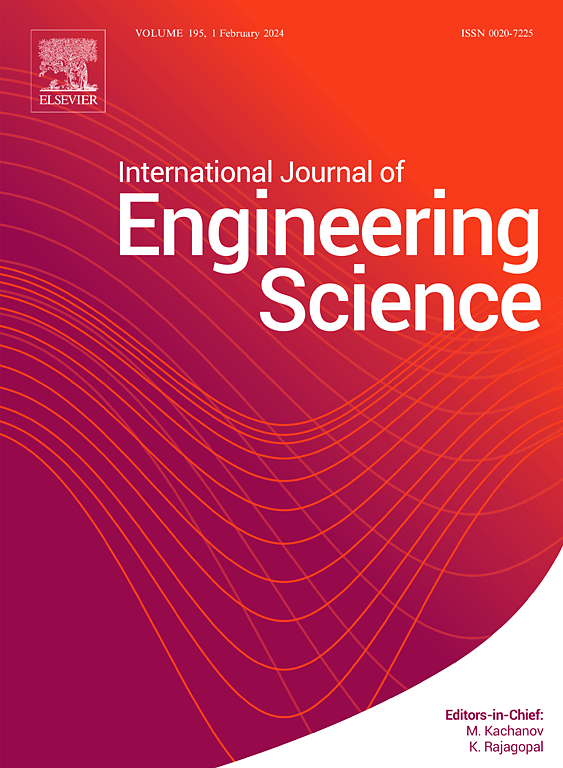Slow translation of a slightly deformed spherical fluid drop in an arbitrary unsteady viscous flow
IF 5.7
1区 工程技术
Q1 ENGINEERING, MULTIDISCIPLINARY
International Journal of Engineering Science
Pub Date : 2025-10-16
DOI:10.1016/j.ijengsci.2025.104401
引用次数: 0
Abstract
The present study investigates the translational motion of a slightly deformed spherical fluid drop suspended in an arbitrary unsteady viscous fluid. The analysis is conducted under the assumption of a negligible Reynolds number, indicating a scenario where the induced stresses are slightly higher than the interfacial tension. Consequently, the drop undergoes a slight deformation but remains intact without breaking. The flow fields in both the interior and exterior of the drop are governed by the unsteady Stokes equations, which are solved asymptotically using a method of regular perturbation expansions under appropriate boundary conditions. The deviation from the spherical shape is quantified by a small parameter referred to as the deformation parameter, which is taken as the perturbation parameter. A complete general solution to the unsteady Stokes equations is employed to solve the equations governing the fluid flow. The hydrodynamic forces on the drop are then determined and expressed in terms of Faxén’s law for an arbitrary ambient flow field. The hydrodynamic problem is tackled up to the first order of the deformation parameter, disregarding higher-order terms. Closed-form expressions for the hydrodynamic drag force acting on the drop are derived for the specific scenarios of prolate and oblate spheroidal drops. The hydrodynamic forces obtained in the present study agree with the respective hydrodynamic forces experienced by prolate and oblate spheroidal drops in the limiting case of steady flow, as existing in the literature.
任意非定常粘性流动中轻微变形的球形液滴的缓慢平移
本文研究了悬浮在任意非定常粘性流体中的微变形球形液滴的平移运动。分析是在假设雷诺数可以忽略的情况下进行的,这表明在这种情况下,诱导应力略高于界面张力。因此,液滴经历了轻微的变形,但保持完整而不破裂。液滴内部和外部的流场由非定常Stokes方程控制,该方程在适当的边界条件下用正则摄动展开法渐近求解。从球体形状的偏差是量化的一个小参数称为变形参数,这是作为摄动参数。采用非定常Stokes方程的完全通解来求解控制流体流动的方程。在任意环境流场下,液滴上的水动力被确定并以faxsamn定律表示。水动力问题处理到变形参数的一阶,忽略了高阶项。针对长形液滴和扁球形液滴的具体情况,推导了作用于液滴的水动力阻力的封闭表达式。本研究得到的水动力与文献中存在的长形液滴和扁球形液滴在稳定流动的极限情况下所经历的水动力相一致。
本文章由计算机程序翻译,如有差异,请以英文原文为准。
求助全文
约1分钟内获得全文
求助全文
来源期刊

International Journal of Engineering Science
工程技术-工程:综合
CiteScore
11.80
自引率
16.70%
发文量
86
审稿时长
45 days
期刊介绍:
The International Journal of Engineering Science is not limited to a specific aspect of science and engineering but is instead devoted to a wide range of subfields in the engineering sciences. While it encourages a broad spectrum of contribution in the engineering sciences, its core interest lies in issues concerning material modeling and response. Articles of interdisciplinary nature are particularly welcome.
The primary goal of the new editors is to maintain high quality of publications. There will be a commitment to expediting the time taken for the publication of the papers. The articles that are sent for reviews will have names of the authors deleted with a view towards enhancing the objectivity and fairness of the review process.
Articles that are devoted to the purely mathematical aspects without a discussion of the physical implications of the results or the consideration of specific examples are discouraged. Articles concerning material science should not be limited merely to a description and recording of observations but should contain theoretical or quantitative discussion of the results.
 求助内容:
求助内容: 应助结果提醒方式:
应助结果提醒方式:


